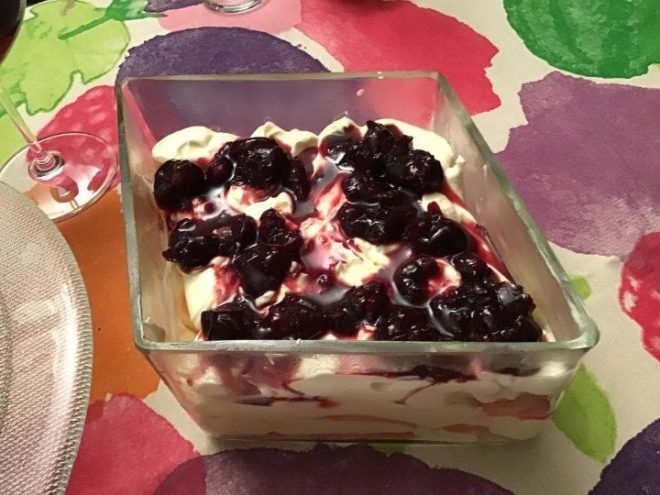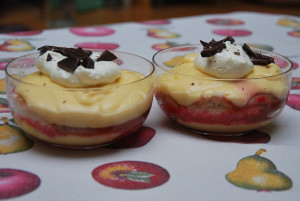I have never made traditional dishes for Christmas obligatory and my menu choices depend on the people I am sharing Christmas with. Last year it was fresh seafood – oysters, prawns and crayfish – simply served and delicious. This year main course is likely to be duck with cherries marinated in grappa. What comes before and after is to be yet decided.
When my parents were alive, our family Christmas meal was likely to be a combination of offerings from Sicily and Trieste, either a caponata or an insalata russa for the finger food, a good brodo with tortellini for firsts, while the second course varied from year to year, and perhaps there was a cassata or a zuppa inglese for dessert. Only fish on Christmas eve was obligatory, but there was never a set Christmas menu, as there tends to be in many Australian or Italian households.
You won’t find me cooking turkey because it is too much like chicken, for me. As for dessert – I am not a fan of Christmas pudding and the only parts of pavlova I like are the berries and cream. I have made too many cassate (plural of cassata) and panforte on too many occasions to repeat them or appreciate them as I once did at Christmas.

This year, probably the only traditional Christmas dish I’ll be eating is Zelten, a typical sweet, fruit and nut bread/cake of the Trentino-Alto Adige region of Italy.
I’ve looked at numerous recipes and background information about Zelten and found that there are many variations in the recipes. Zelten began from humble beginnings, a bread dough enriched with the typical local dry fruit and spices, the quantity and quality of fruit being poor in some (as in Trentino) and extravagant in others (as in Balzano).

The numerous recipes I read varied greatly. For example, walnuts are the principal nut used in all the recipes, but some variations contain almonds and/or hazelnuts/ pine nuts. Apart from figs and dried grapes, there are recipes with dates and/or unspecified dried fruit. To me using dates and mixed fruit do not sound typical of Tyrol.

All recipes include flour, either wheat or rye (some use very little flour, other recipe have large amounts of dough, some use bread dough). There are varying amounts of eggs, butter, sugar, yeast, milk or none of these. The fruit can be steeped in rum, but some recipes specify grappa, so as you can see the recipes vary greatly and some are much more modern.
I can understand the many variations of Zelten in Tyrol and why the recipes differ from family to family and location. Tyrol (German: Tirol) is historically a multi-national region located in the heart of the Alps of Austria and Italy. It is segmented by the compass into North, East and South Tyrol. North and East Tyrol lie in Austria and South Tyrol is in Italy, it is also known as Südtirol or Alto Adige). Bolzano, is the capital.

I was in this region two years ago and enjoyed its many special features: stunning scenery especially in the Italian Alps and the Dolomites with their extraordinary mountainous and rocky peaks, the distinct architecture of cities and ancient villages where people speak German or Austro-Bavarian-German and Italian, and obviously, the culinary delights that reflect these cultures.


Zelten comes from the German selten and it means sometimes/on occasions, and as the name indicates it was only prepared on special occasions like Christmas, in winter with only dried fruit and nuts available.

I finally settled on making a version of a Zelten from South Tyrol and Bolzano, characterized by of large amounts of fruit – mainly figs and a selection of other dried fruit, pine nuts and almonds. I conducted some research into the fruit that is grown in the region and omitted apricots, peaches or plums because these stone fruits are more recent additions to the orchards. I used dried apples, pears, sultanas, strawberries (there are wild strawberries in the woods), a few dried plums and only a little orange peel as I did not imagine citrus to be very common in the area.

I chose grappa rather than rum, and plenty of it to soak the fruit and to moisten the cake once it was made.
I used no butter, eggs, milk or yeast and I used rye flour because wheat does not grow well in wet and cold climates. I used honey and not sugar.
I divided the mixture and baked two round cakes.
Eventually, I combined a couple of recipes and came up with:
750g dried fruit – 400g were figs, the rest as described above
350g nuts – 120g walnuts, the remainder almonds and pine nuts
200g honey
grappa – about ½ litre to soak the fruit and another ½ litre to soak into the baked cake
ground cinnamon, cloves, grated lemon peel
rye flour
I combined coarsely cut fruit and chopped nuts in a large container with a cover, added the grappa and left it for four days, stirring it occasionally.
I added the honey and spices and gradually mixed in as much rye flour as it would absorb. The principal recipe suggested to use 5% of the total weight of the ingredients, I calculated this to be about 230g. I mixed a teaspoon of baking powder to the flour as the only leavening, there was no leavening mentioned in the recipes that I sighted that used rye flour.
I lined two round baking tins with brown paper and baking paper. The recipe did not specify heat or time, but I baked them at 200 degrees for 60 minutes. Although my cakes are round, my understanding is that in different parts of Tyrol oval or heart shapes are also common.
I wrapped the cakes in calico( pudding cloth) and I have been dousing it with more grappa daily.
I took a cake to friends last night and we cut it. It is heavy, not sweet and steeped in grappa. It does taste good.

Back goes the calico wrapping. With all that alcohol and fortress -like wrapping, the Zelten will last for a long time.

Grappa is made with grape skins. The wines and grappa from this region is unique.

Recipes of food mentioned in this post.
ZUPPA INGLESE, a famous, Italian dessert
CASSATA Explained with photos
SICILIAN CASSATA and some background (perfect for an Australian Christmas)
CAPONATA Catanese (from Catania) made easy with photos
INSALATA RUSSA (Party time; Russian salad)
Like this:
Like Loading...












 Over summer and the Christmas period I did make a few favourite standout dishes that were requested time and again: Zuppa Inglese and Caponata Catanese seem to have left such a lasting impression on my friends and family that they’ve become favorites for special occasions.
Over summer and the Christmas period I did make a few favourite standout dishes that were requested time and again: Zuppa Inglese and Caponata Catanese seem to have left such a lasting impression on my friends and family that they’ve become favorites for special occasions.





































































